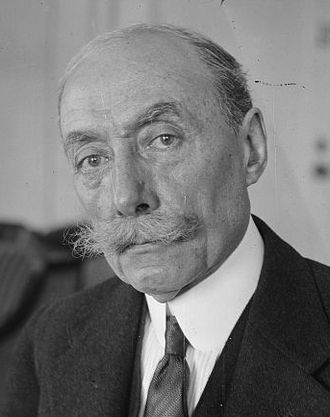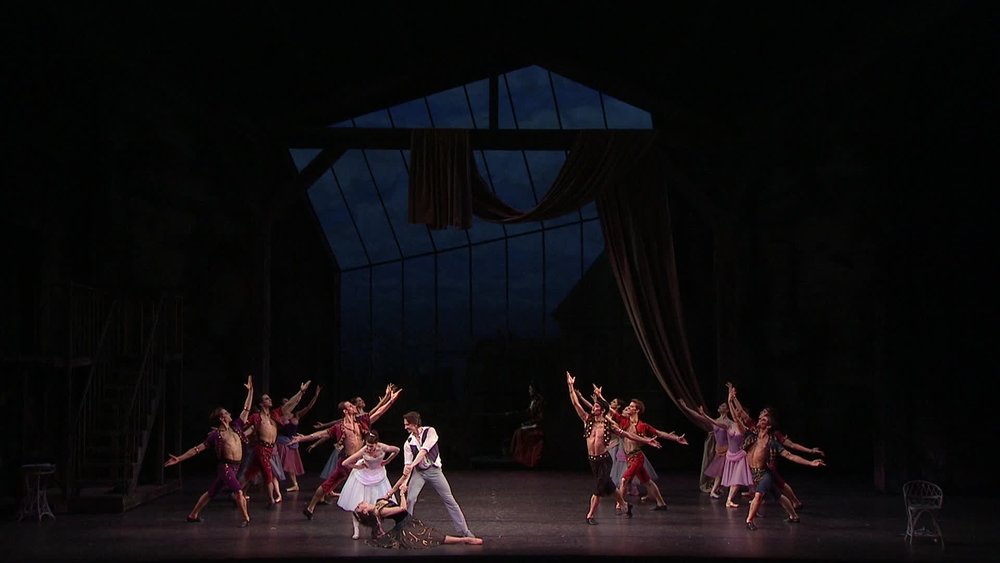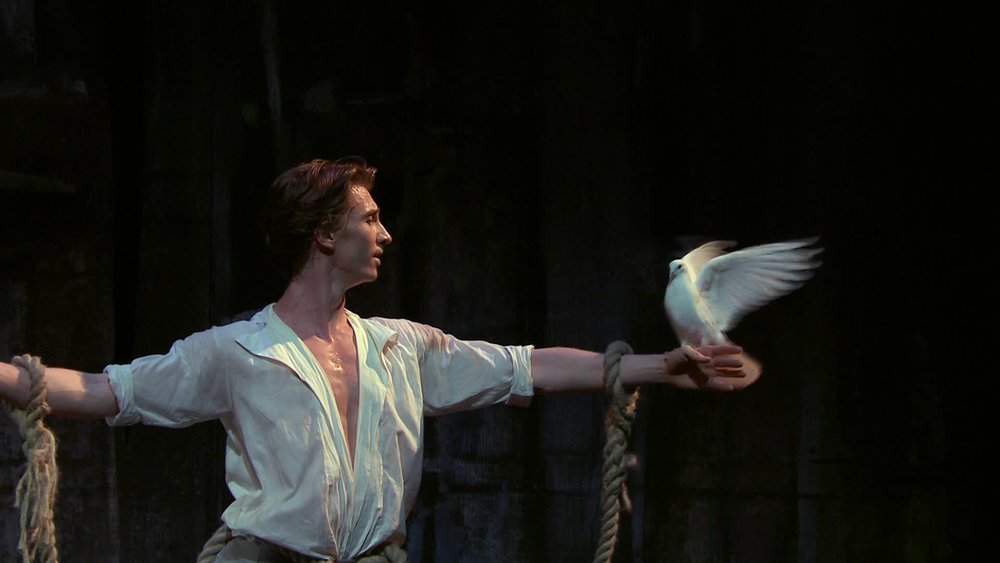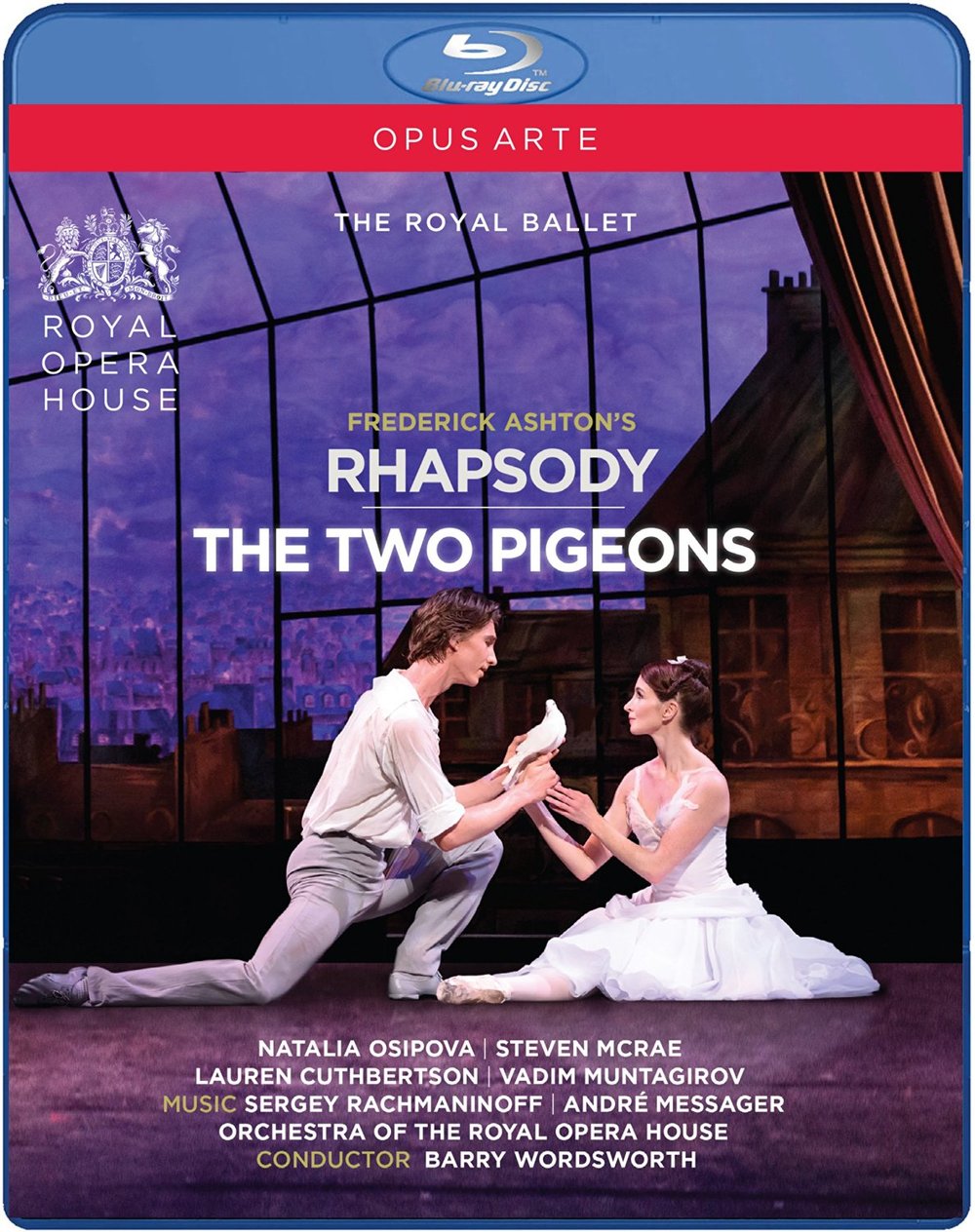
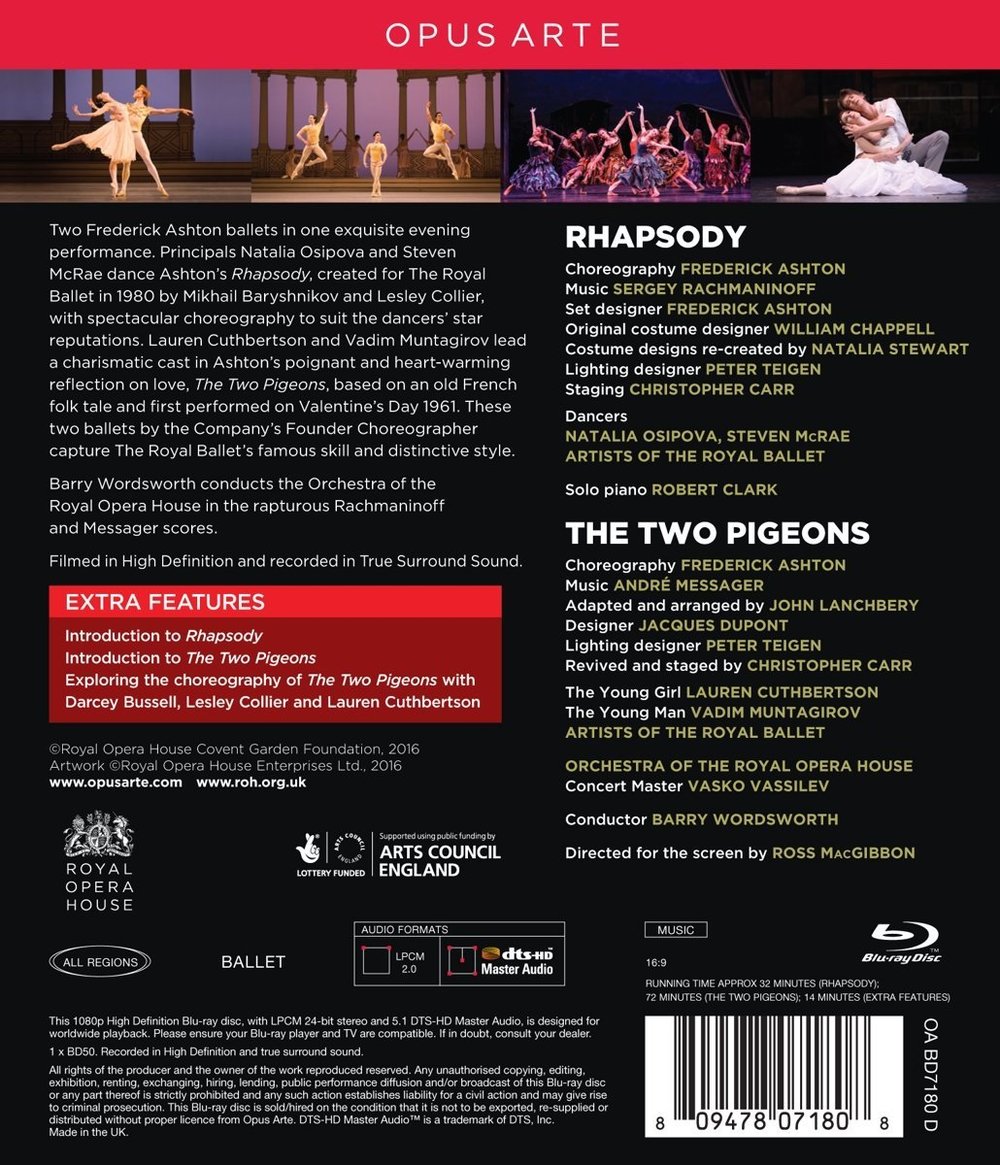
Frederick Ashton Rhapsody and The Two Pigeons ballets:
Steven McRae and Natalia Osipova star in Rhapsody supported by Olivia Cowley, Elizabeth Harrod, Meaghan Grace Hinkis, Emma Maguire, Yasmine Naghdi, Beatriz Stix-Brunell, Luca Acri, Tristan Dyer, Nicol Edmonds, Benjamin Ella, Kevin Emerton, and Marcelino Sambé of the Royal Ballet. Music is Rachmaninoff's Rhapsody on a Theme of Paganini. Barry Wordsworth conducts the Orchestra of the Royal Opera House (Concert Master Vasko Vassilev); solo piano by Robert Clark. Sets by Ashton; original costumes by William Chappell recreated by Natalia Stewart; lighting by Peter Teigen; staging by Christopher Carr; ballet mistress was Samantha Reine; principal coaching by Alexander Agahzhanov and Lesley Collier; Benesh notator Grant Coyle.
The Two Pigeons is danced by Lauren Cuthbertson (The Girl Friend), Vadim Muntagirov (The Artist), Fumi Kaneko (The Gipsy Princess), Ryoichi Hirano (The Gypsy Prince), and Marcelino Sambé (Gypsy Boy) supported by Elizabeth McGorian, Elizabeth Harrod, Meaghan Grace Hinkis, Chisato Katsura, Mayara Magri, Emma Maguire, Yasmine Naghdi, Romany Pajdak, and Leticia Stock of the Royal Ballet. Music is by André Messager adapted and arranged by John Lanchbery. Barry Wordsworth conducts the Orchestra of the Royal Opera House (Concert Master Vasko Vassilev). Designs by Jacques Dupont; lighting by Peter Teigen; revived and staged by Chistopher Carr; ballet mistress was Samantha Reine; principal coaching by Gary Avis, Christopher Carr, and Lesley Collier; Benesh notator Gregory Mislin.
Directed for TV by Ross MacGibbon. Released 2016, disc has 5.1 dts-HD Master Audio sound. Grade: B for Rhapsody, C+ for The Two Pigeons, and B- blended grade.
Rhapsody
Rhapsody was written in 1980 as a showpiece for Mikhail Baryshnikov. To make a great ballet, it helps to start with great music. Rachmaninoff's Rhapsody on a Theme of Paganini fills that bill and gives this piece its name. So let's start with a screenshot of Robert Clark on the piano:
Baryshnikov is about age 69 now. I can't think of any younger dancer who has attained the same level of esteem that Mikhail once enjoyed. But if anyone at the Royal Ballet has a shot at this, probably it would be Steven McRae, shown below, a master of classical ballet, modern dance, and tap:
This is abstract dance, but McRae seems to be cast as Emperor of a mythical realm of dance populated by 6 men and women. Unfortunately, the splendor of this realm is overcast in gloom and shadows. The center of the stage has moderate light; the area close to the scenic architecture and steps are too dark for the cameras to cope with. It's a bit shocking to see video images this poor made in 2016!
Here's a closer shot of the women. The pair in the foreground are fairly visible. The other four ladies are poorly placed in the shadows:
But here the men share equally in glory in the middle of the illuminated area:
This next shot of 3 women below in the shade does have a special allure. (It looks great as wallpaper on one of my PCs):
Not a bad near shot of 3 of the men:
The Empress (Natalia Osipova) makes a dramatic appearance under the arch. Alas, her beauty is mostly obscured by deep shadows. Finally we get her out into the center of the stage where she is glorious under the light:
And now the whole court is assembled:
Among his many brilliant moves, McRae does some spectacular jumps that defy screenshots. I think the shot below is the dance equivalent of a rhapsody:
Rhapsody ends with a bit of a smirk, which fits McRae's public persona. I have no idea if this is part of the libretto:
Because there is no story line in Rhapsody, there's no need or excuse for a lot of close-ups showing actions or emotions of individual dancers. I ran a Wonk Worksheet on Rhapsody. The film turns out to have 170 video clips in 1717 seconds of dancing for a fairly stately pace of 10.1 seconds per clip. This is not as slow a pace as I would like to have seen, but it does get us out of DVDitis territory and over the threshold of acceptable video content. Most ballet fans will be pleased by the fact that 77% of the video clips show the whole stage or the whole bodies of the dancers pictured. There are only 2 close-ups.
This is an excellent ballet full of bravura dancing. The music is wonderful, well recorded, and rendered with good SQ. Video content is also quite acceptable. But alas, I'm frustrated by the weak PQ caused by dim lighting. I've always understood that Opus Arte is owned by The Royal Ballet. If this is still true, there's no finger to point to somewhere else. Management failed to give Ross MacGibbon the light he needed to make the kind of video the home audience deserves. Grade: B
The Two Pigeons
I had never heard of the composer André Messager. That's because the only thing he wrote still around today for enjoyment by the general public is the music to The Two Pigeons. Contrary to the fate of many composers, Messager seemed to have a happy-go-lucky life full of friendships and the excitement of working in Paris and London at a time when life there was fun. His first major gig was his appointment as conductor of the orchestra at Folies Bergère, the famous Paris night club. This sure beats spending a whole life playing the organ in churches like Bach or Messiaen. (I'm being too flippant. Messager also played some in churches, and his best job late in life was conducting at Covent Garden in London.)
Below, a rather droll picture of Messager:
The Folies Bergère:
Since Messager went to work at Folies Bergère 1878, he no doubt knew the painter Édouard Manet, who in 1882 first showed his famous painting The Bar at Folies Bergère (seen below thanks to the Lyon Municipal Library). This is what Paris looked like while Messager wrote The Two Pigeons, which came along 4 years later. In case you are wondering, the legs and green shoes in the upper left corner of the picture belong to a trapeze artist. The woman serving at the bar was named Suzon. Messager was a close friend of the composer Emmanuel Chabrier. Messager doubtless knew Suzon, because Chabrier was the first owner of The Bar at Folies Bergère, which Chabrier displayed above the piano where he composed. Life may have been fun for the artists of this era and their wealthy patrons, but not so much this employee of the Bergère, who looks desperate. That's because along with the drinks being sold by the house, the house was also selling Suzon:
The Folies Bergère had cabaret, not ballet. In 1886, Messager moved up a step to the Paris Opera Ballet for the premiere of Les Deux Pigeons. This was during a time of decadence at the Paris Opera Ballet, so perhaps the step up for Messager was a small one. For more on this subject see La Petite Dansuese de Degas, which deals with shocking conditions at the POB in that era:
Fast forward 130 years, and we now see the Ashton/Royal Opera House setting for The Two Pigeons. The Artist (Vadim Muntagirov) is working on a painting using his Girl Friend (Lauren Cuthbertson) as a free model. She's bored and interested in romance; he needs to finish some work. If you look really hard, you can see two white pigeons outside on the porch railing:
8 buddies of the Girl Friend drop by for a visit. That's what the keepcase booklet says. But who has 8 friends who will simultaneously climb 6 flights of steps to get to a Paris garret? And what elderly neighbor woman lives in such a place? I prefer to imagine that there's a ballet school next door. Anyway, all the girls do a fantastic job of dancing like pigeons walk:
Suddenly Gypsies come wandering by and climb 6 flights of stairs. The group consist of the Gypsy Princess (Fumi Kaneko) and her Honor Guard of 9 young Gypsy men:
The Artist, exasperated with the Girl Friend, immediately takes a shine to the Gypsy Princess:
Which almost results in a girl fight (I keep hoping to see the Royal Ballet stage one of these):
The pigeons break up, and The Artist storms off to find the Gypsy Princess. The Girl Friend weeps as her 8 buddies stage mock lamentations:
That's the end of Act 1. So far, I'm sorely puzzled. 8 beautiful, lonely, hot French girls suddenly find themselves in the same room with 8 handsome Gypsy escorts---and nothing happens. That's hard to believe. Somehow this libretto must have gotten terribly mutilated. Well, we must now proceed in Act 2 to the Gypsy camp:
Maybe the shot below explains why the Gypsy guys were not interested in the French girls:
The Artist approaches the Gypsy Princess on the pretext of drawing her picture. Now we get a better shot of the Gypsy Prince and Captain of the Honor Guard (Ryoichi Hirano):
The Artist foolishly thinks he's making progress:
But he's being played. The Princess challenges the men to fight for her:
The Artist is lucky to get out of the camp alive. But he's not alone:
Reconciliation:
What should I make of this sappy ballet? Although uninspired, the music is serviceable for what you see on stage. I'm sure that Barry Wordsworth knows this music well, but I get the impression that the Orchestra of the Royal Opera House is sight-reading. Or maybe they just hate it after playing Rachmaninoff. In addition, the recording sounds stuffy especially with tubby bass.
I worked up a Wonk Worksheet on The Two Pigeons. The average clip last just a bit over 7 seconds, a pace which we associate with DVDitis in the case of symphony recordings. Only 64% of the clips show the whole bodies of the dancers. Stated differently, 36% of the clips are "no feet", "torso", or close-up shots that are maybe good for story-telling but bad for enjoying a dance program. I get the impression that MacGibbon tried to save this weak libretto by spicing it up with lots of short video clips.
Since I find little to praise in this recording, I'll give it a C, but I'll move that to a C+ out of respect for the excellent dancing skills of all involved.
Sorry, I couldn't find any suitable clips for Rhapsody and The Two Pigeons on YouTube. The official trailer from Opus Arte incorrectly shows Laura Morera as dancing the Gypsy Princess. I'm sure Laura did a great job of this in live rotations. But Fumi Kaneko is the one who stars in the video, so the trailer showing Laura is just another example of lax quality control.
OR














